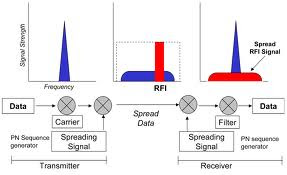A 2.4GHz radio system which selects one (or two) of the available "free" frequencies and transmits only on the one(s) chosen. Like FHSS (Frequency Hopping Spread Spectrum) systems, it is resistant to electrical noise. See also: FHSS.
Wikipedia: In telecommunications, direct-sequence spread spectrum (DSSS) is a modulation technique. As with other spread spectrum technologies, the transmitted signal takes up more bandwidth than the information signal that modulates the carrier or broadcast frequency. The name 'spread spectrum' comes from the fact that the carrier signals occur over the full bandwidth (spectrum) of a device's transmitting frequency. Certain IEEE 802.11 standards use DSSS signaling.
DSSS - Direct Sequence Spread Spectrum
Direct Sequence Spread Spectrum (DSSS) is a spread spectrum technique whereby the original data signal is multiplied with a pseudo random noise spreading code. This spreading code has a higher chip rate (this the bitrate of the code), which results in a wideband time continiuous scrambled signal.
Direct Sequence Spread Spectrum
DSSS significantly improves protection against interfering (or jamming) signals, especially narrowband and makes the signal less noticeable. It also provides security of transmission if the code is not known to the public. These reasons make DSSS very popular by the military. In fact, DSSS was first used in the 1940s by the military.
DSSS can also be used as a multiple access technique, whereby several different pseudo random spreading codes are being used simultaneously. This multiple access technique is better known as Direct Sequence CDMA.
DSSS is e.g. used in IEEE 802.11b and Zigbee.












0 comments:
Post a Comment